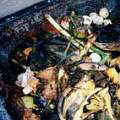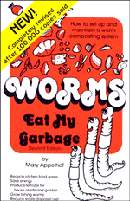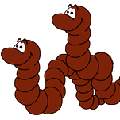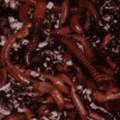| 作者:Erik Ness10.11.00
在冬天會遇到的問題是沒有東西會在這個時候腐爛

哇!以行動來堆肥
照片來源:德州農工大學園藝科學及農科園藝系
如果你沒有習慣堆肥,這或許不會困擾你。但如果你有堆肥,你將會束手無策。堆肥中那不可思議的微生物引擎和冬天的嚴寒是沒有辦法配合的。雖然在春天來臨後,這個在地底的微小生態系可神奇地將咖啡渣和三明治屑變成得獎的美麗天竺葵。
如果你還是堅持在冬天的幾個月中,離開你家溫暖的廚房,經過寒冷的跋涉到達那休眠的堆肥,盡職的處理你的馬鈴薯皮及蜜蜂阿姨的水果蛋糕,你可以預期三件事:a、你的大箱將很快裝滿了奇形怪狀的冰凍花椰菜梗和青豆,b、在春天來時這些東西將會變成潮濕的膠狀物質c、會招致敏感的鄰居或是市政府的健康部門及其他各種害蟲的光顧。
對此困境,許多人在這個季節停止堆肥,將他們的有機廢物丟到市立的衛生設備或地區性的下水道。但是這個舉動通常會增加政府的花費,以及剝奪了地球上容易回收的珍貴養分。這也讓你失去了在公司的假日宴會中有個絕對不會失敗的開場白:「我養蟲蟲當寵物。」
我的蟲蟲住在地下室裡的堆肥箱中,每當廚房的堆肥桶溢滿時,我都會拿著這些殘羹剩飯踱下樓。這有點像在養豬,但是蟲蟲不會臭,他們也不會發出咕嚕咕嚕的噪音或高聲尖叫。而且它們的糞便是植物上好的食物,是堆肥之后,是糞中之糞。

好吧!你還沒被說服。通常人們在地下室發現蟲時會打電話給驅蟲公司,甚至房地產經紀人。但這個例子是真的可行的。Mary Applehoff絕佳的以蟲堆肥指南Worms Eat My Garbage中就曾經刻劃一個高明、蓋有木板的廚房蟲箱設計。(如果你真的執著的話,我會建議另一本姊妹作:青少年創作經典──如何食用炸蟲子,其中描寫這麼一道菜。)
你幾乎可以將蟲子養在你家的任何一個角落,但是或許你該先和家裡的人商量一下。1997年「蚯蚓一書」的作者回憶起當他還是有機種植的工作人員時所收到一個女人寄來的一封絕望的信。他的丈夫將蚯蚓養在他們的床下,他說他在想這是否可構成離婚的條件。在經過辦公室內的一陣哄堂大笑,我們回信告訴她這是個人習慣,但如果所有的東西都在箱子裡的話,我們看不出任何問題。
全球性蟲化
在今日,雖然蟲子缺乏性的吸引力,但它們不是一直都這樣的。雖然沒有古書或考古學的證據可證實克麗歐佩特脫拉在床下有個蟲箱,但她真的曾宣告這些小小的爬行動物是神聖的,而且禁止採集或傷害它們--這顯然不能反映她的愛情生活。

達爾文和蚯蚓老兄
當達爾文還不是不可顛覆的模範之時對蚯蚓就有極高的評價。在物種原始和人類的起源後,在他死前又寫了經由觀察蚯蚓的習性行為來了解蔬菜霉的形成。「這該懷疑,世上有多少其他的生物像這些低等生物一樣,能在世界歷史上扮演著如此重要的角色。」他如此下結論。
對此,Minnich有相同意見。他在「蚯蚓一書」中寫到蚯蚓在人類偉大文明的建構上扮演著重要的角色。如果沒有這種生物的話,事實上,人類還可能是以原始人、半原始人或很糟糕的狀態存在著,將他大部分的能量花在生長、找尋食物和擊退攻擊者上。

如同這些證據,Minnich引用歷史上在美索不達米亞平原發達的農業社會就是靠這些一在土壤中工作的蚯蚓而發跡的。在美國大西洋岸的農產量和其他地方由殖民者無心帶來的蚯蚓有著無法測量的收穫也有異曲同工之妙。換句話,說要感謝這低等的蚯蚓的不只是有機籚筍,連Napster、丹佛野馬隊和核子武器庫都應感謝它們。
當然,在對生態議題敏感的今天,不是所有蟲蟲的工作都一致被認同。在美國大部分的蟲蟲似乎都是具有攻擊性的。外來種會排擠本地種,而且科學家們開始研究這些外來種可能已經造成一些本地生態系的傷害。你家鄰近的地區多半在很久前已經被開發,所以要根絕外來種就像是要革除蒲公英一樣,是不可能有結果的。所以如果你仍然不想讓情況惡化,或許你應該重新考慮任何一個過度熱心的計劃,例如說帶你的蟲子到加拿大落磯山脈做趟旅行。(就這點來說,蟲蟲是理想的寵物,當你環遊世界時,它們可以幾個月不吃東西。)
如何餵食這些野獸
對蟲蟲具有崇高的熱情並不是以蟲做堆肥的必要條件。事實上,開始堆肥前你只需要四個充要條件:對平均每週所產生的廚餘量有個概念、一個蟲箱、並且幫蟲舖墊,當然,還有那蠕動的小蟲。

箱子的樣本繪圖:Seattle Tilth.
你幾乎可以餵蟲蟲任何東西,除了肉或骨頭外,而且不要有太多的乳酪、奶油或油。你每週所製造出每磅的食物殘渣將需要一平方英呎箱子的空間。蟲蟲是在表面攝食的,所以不要讓箱子的深度超過一呎。你可以用塑膠盒、木片、三合板來做箱子。在箱底每6吋的地方鑽一個四分之一吋的洞以便讓箱子可以通風及排水。
你將需要生物可分解性的舖墊以便能保持較多的濕氣,但也要讓空氣可以流通以免產生氣味。你可以用葉子、泥煤苔、稻草或碎報紙條或起皺紋的紙板。加上兩把土以便開始細菌性的分解及提供蟲子消化道所需的沙礫。
我是使用葉子,因為它們不用錢,而且容易取得。但它們會糾結在一起而變得比較難掩蓋住食物殘餘物。(你也需要將其他動物和葉子一起置入,如馬鈴薯蟲、躍尾蟲及蜈蚣。這將會對堆肥有所助益,但這也可能令人困擾)泥煤需要錢,而且對蟲來說可能有點太過酸性。(碎蛋殼可以減緩這個現象)稻草分解得很慢,而且也很難使其濕潤。碎紙和厚紙板或許對你家附近的回收者比對蟲蟲來得有用,不過你如果用紙的話,保持紙張的濕潤。(偏執狂注意:一個蟲箱將完美的取代你的碎紙機。世界上沒有一個犯罪鑑識專家能在蟲蟲的便便中查出你的信用卡號碼)而且要記得避免使用印有彩色油墨的紙,因為其中會含有對蟲或對你的園藝有害的重金屬。

蟲蟲行動照片來源:City Farmer
一旦你將舖墊濕潤了之後,對蟲子來說就一切就緒了。園藝品種的蚯蚓不會在這種環境下大量繁殖,而且還有可能會試著逃跑。紅孑孓,或者又叫紅蟲或糞蟲,比較理想。它們能在一天之內吃下與它們同重的食物,而且它們的繁殖能力強,這些蟲可以郵購方式訂購,或在地方的餌店取得,或是從沃土中挖出。
在當你想要餵蟲的時候餵食它們,但是時間越規律越好。小片的食物分解得較快,想像箱子是一個九宮格,一次用一個版塊,在下一次重頭開始前把所有的版塊先用光。留在表面上的碎屑容易招來果蠅,雖然如此,但是不要把它們埋太深。一塊黑塑膠板可以隔絕光線及保持溼度。
在3或4個月後你的箱子中將會有高養分的黑土。如果春天到了,而你又不打算在秋天前再做蟲子堆肥,你可以將箱裡面的土當作肥料傾倒在花園或草坪上。如果你想要保有你的蟲蟲,明亮的光線會讓它們到箱底去,所以你可以只將堆肥除去。或者,你可以將堆肥推到箱子的一邊,在另一邊倒滿新鮮的舖墊及新的垃圾,蟲蟲將會遷移到新的舖墊中。
一旦你開始以蟲做堆肥,蟲蟲就真的會開始工作。如果你給它們食物及庇護所,這些亞里斯多德所謂的「地球的小腸」將會使你在這個星球上所擁有自己的角落更為肥沃。
Erik Ness是 MAMM雜誌和 Madison's週報的約稿記者,以及Milwaukee 雜誌, Madison雜誌, and Wisconsin Trails的特約記者.
全文及圖示詳見 : http://www.gristmagazine.com/grist/maindish/
ness101100.stm
版權歸屬 Grist Magazine 環境信託基金會 (楊璧如 譯,陳中煌 審校)
中英對照譯稿請見:http://news.ngo.org.tw/issue/surround/2000/issue-surround00121401.htm
|
|
by Erik Ness 10.11.00
The problem with winter is that nothing rots.
Yummy! -- compost in action.Photo: Texas A&M Dept. of Horticultural Sciences and Aggie Horticulture.
This won't bother you if you don't have a compost pile, but if you do, you are frozen on the horns of a messy dilemma. The wondrous microbial engine of your compost pile is no match for the big chill of winter. The tiny ecosystem that magically changed coffee grounds and sandwich crusts into prize-winning geraniums is chased underground until spring.
If you still insist upon leaving your warm kitchen during the winter months for gelid treks to your dormant compost pile to conscientiously dispose of potato peels and Aunt Bee's fruitcake, you can count on three things: a) your bin will quickly fill with bizarre frozen constellations of broccoli stalks and green beans worthy of Jackson Pollack that b) will transform themselves into a sloppy, gelatinous mess come spring that c) may provoke unwelcome scrutiny from delicate neighbors, the city's health department, and other assorted vermin.
Faced with this dilemma, many people stop composting for the season, abandoning their organic wastes to city sanitation or the local sewer district. But this increases the cost of city services and deprives the earth of valuable nutrients that could easily be reclaimed. It also robs you of a no-fail conversation starter for your company holiday party: "I have pet worms."
My worms have always lived in a composting box in the basement. Whenever the kitchen compost bucket overflows, I trudge downstairs with the slops. It's kind of like keeping pigs, but worms don't smell, they don't grunt or squeal, and their manure is the plant food of the gods, the queen of compost, shit extraordinaire.
Okay, you're not convinced. Normally people with worms in their basement call their exterminator, perhaps even their realtor. But this really works. Mary Applehoff's excellent guide to vermicomposting, Worms Eat My Garbage, even pictures a cleverly designed kitchen worm bin topped by a cutting board. (If you get really hard core, I'd suggest a companion volume, the juvenile fiction classic How to Eat Fried Worms, featuring such cuisine as the Whizband Worm Delight.)
You can keep your worms just about anywhere in your home, but you may want to consult with housemates first. Jerry Minnich, author of the 1977 opus The Earthworm Book, recalls a desperate letter he received from a woman while he was on the staff of Organic Gardening. "Her husband was composting earthworms under their bed," he says. "She was wondering if this was grounds for divorce." After exhausting the potential for intra-office humor, "we wrote back to her saying that this was a personal manner, but that if everything was contained within the bin we didn't see any problem."
Global Worming
Granted, worms lack for sex appeal in this day and age. But it was not always thus. While there is as yet no hieroglyphic or archeological evidence that Cleopatra kept a worm bin under her bed, she did declare the little crawlers to be sacred and forbade their harvest or harm -- all without apparent repercussions to her love life.
Chuck D. and a worm buddy.
Charles Darwin, too, when not toppling paradigms, spoke highly of the earthworm. Shortly before his death, he followed up The Origin of Species and The Descent of Man with The Formation of Vegetable Mould through the Action of Worms with Observations on their Habits. "It may be doubted whether there are many other animals which have played so important a part in the history of the world as have these lowly organized creatures," he concluded.
Minnich concurs, writing in The Earthworm Book: "The earthworm has played a paramount role in the building of man's great civilizations. Were it not for this creature, in fact, it is entirely possible that man would still be subsisting in a primitive, semiprimitive, or squalid state, devoting most of his energies to growing or gathering food and fighting off attackers."
As evidence, Minnich cites scholarship linking the rise of great agricultural societies in the Fertile Crescent to prolific soil-working earthworms. Similarly, agricultural productivity on the Atlantic Coast of the United States and elsewhere gained immeasurably from the earthworms the colonists unwittingly brought with them. In other words, thank the lowly earthworm not only for organic asparagus, but for Napster, the Denver Broncos, and nuclear arsenals.
Of course, in this day of ecological sensibilities, the work of worms is not universally acclaimed. It seems most resident American worms are invasive species, exotics that have supplanted native species, and scientists are beginning to learn that they may as yet cause great harm to some native ecosystems. In all likelihood, your neighborhood was colonized long ago, so stamping out exotic worms is about as fruitless as a crusade against dandelions. Still, so as not to exacerbate the problem, you should probably reconsider any overzealous plans to bring your worms along on backpacking trips in the Canadian Rockies. (In this sense worms are ideal pets for the commitment-challenged. They can go without food for months while you travel the world 'round.)
How to Feed the Beasts
A messianic passion for worms is not a requirement for vermicomposting. In fact, to get started you only need four things: a sense of how much kitchen waste you generate in an average week, a worm bin, bedding for your worms, and -- of course -- the squirmers themselves.
An example bin.
Diagram: Seattle Tilth.
You can feed worms most anything except meat or bones, and not too much cheese, butter, or oil. For every pound of food waste you create per week, you'll need one square foot of bin space. Worms are surface feeders, so don't make your bin deeper than one foot. You can use a plastic tub or construct a bin out of scrap wood or plywood. Drill quarter-inch holes every six inches around the bottom and sides to allow ventilation and drainage.
You'll need biodegradable bedding that can hold a lot of moisture but also allow the passage of air so odors don't develop. You can use leaves, peat moss, straw, or shredded newspaper or corrugated cardboard. Add a couple of handfuls of soil to jumpstart bacterial breakdown and provide grit for the worms' digestive tracts.
I use leaves because they are free and easily available, but they can mat down, making it harder to bury your food waste. (With leaves, you also import other critters, such as potato bugs, springtails, and centipedes. By and large, these help with composting, but can be annoying.) Peat costs money, and can be a little acidic for worms (crushed eggshells can ease this). Straw breaks down slowly, and is also hard to moisten. Shredded paper and cardboard are probably more valuable to your local recycler than to the worms, but if you do use paper, keep it moist. (Note to the paranoid: A worm bin can be the perfect complement to your paper shredder. No forensic expert in the world can glean your credit card number from worm droppings.) And remember to avoid using paper printed with color inks because they can contain heavy metals, which aren't good for your worms or your garden.
The worm-up act.
Photo: City Farmer.
Once you have moistened the bedding, it's ready for worms. Garden variety (ahem) earthworms won't thrive in these conditions, and may even try to escape. Red wigglers (Eisenia foetida), also known as red worms or manure worms, are ideal, as they can practically eat their weight in a single day, and they breed prolifically. They can be ordered by mail, procured from local bait shops, or dug out of manure piles.
Feed your worms when you like, but the more regularly, the better. Smaller chunks of food break down faster. Think of the bin as a tic-tac-toe board, and fill in one square at a time, using all the squares before starting over again. Scraps left on the surface might encourage fruit flies, but don't bury them too deep. A piece of black plastic on top will keep light out and moisture in.
After three or four months, your bin will contain a rich, dark soil. If it's spring and you don't intend to vermicompost again until fall, you can dump the bin on your garden or spread it over your lawn as fertilizer. If you want to keep your worms, a bright light will drive them to the bottom of the bin, so you can skim off the compost. Or you can push the compost to one side of the bin and fill the other half with fresh bedding and new garbage, and the worms will migrate.
Once you get started, the worms do the work. If you give them food and shelter, Aristotle's "intestines of the earth" will enrich your own corner of the planet.
Erik Ness is a contributing writer to MAMM magazine and Madison's weekly newspaper, Isthmus, as well as a regular contributor to Milwaukee Magazine, Madison Magazine, and Wisconsin Trails.
http://www.gristmagazine.com/grist/maindish/
ness101100.stm
|
